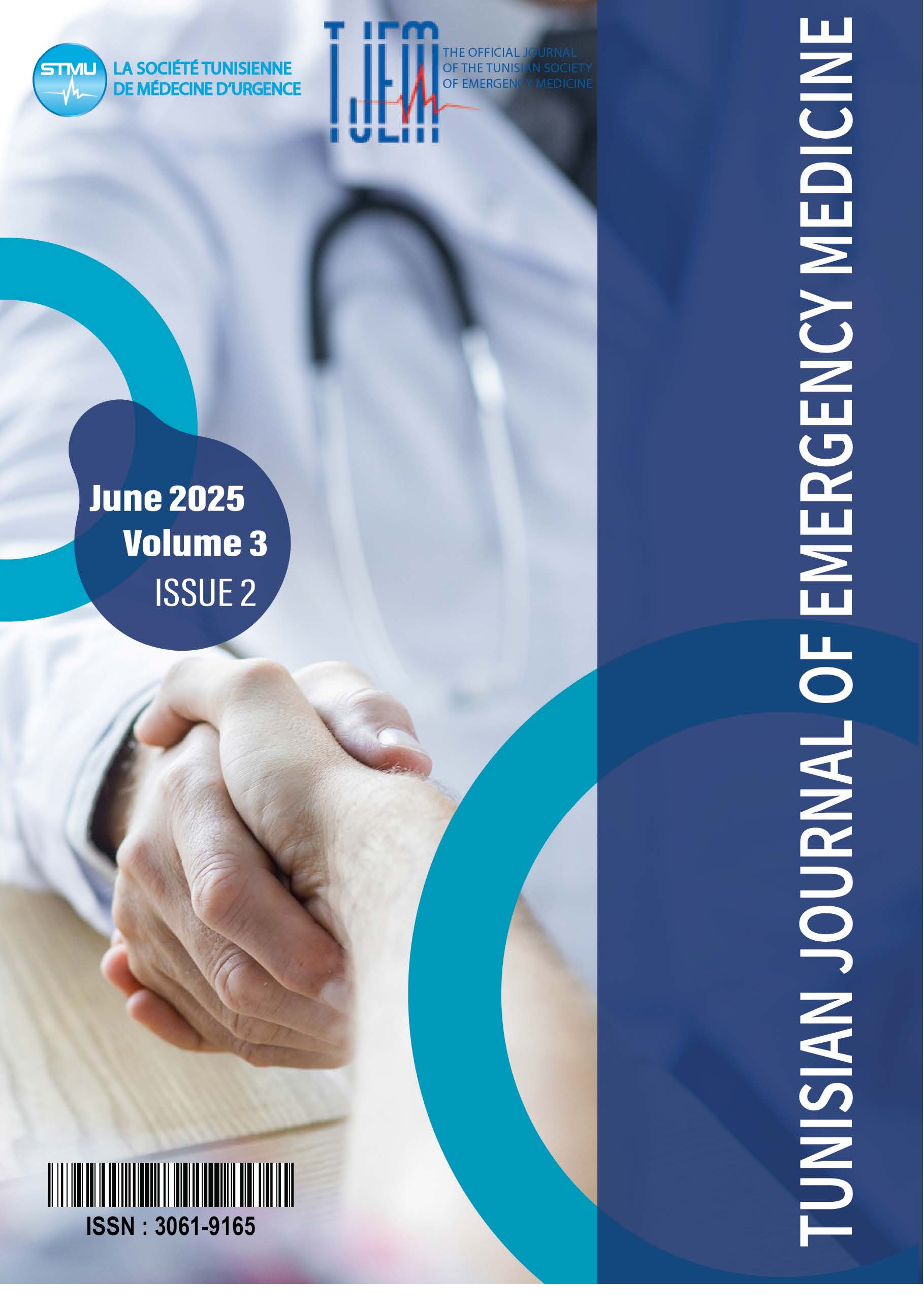Mortality in Pediatric Intensive Care
DOI:
https://doi.org/10.0000/a7e1bc19Keywords:
child mortality, intinsive care units, pediatrics, risk factors, retrospective studiesAbstract
Abstract:
Background: Mortality in pediatric intensive care units is a major concern in critical care medicine due to the unique physiological and clinical characteristics of children. Understanding the causes and complications associated with mortality is essential to improve patient outcomes.
Aim: This study aims to analyze the mortality profile in a pediatric intensive care unit by identifying the main causes of death and associated complications. The objective is to better understand the contributing factors to mortality in order to improve clinical management and care strategies.
Methods: We conducted a retrospective descriptive study including all patients who died in the pediatric intensive care unit at Hedi Chaker University Hospital in Sfax over a one-year period, from September 2023 to September 2024. Demographic data, clinical characteristics, underlying conditions, treatments received, and complications were collected and analyzed.
Results: A total of 41 deaths were recorded during the study period, corresponding to a mortality rate of 14.08%. The highest mortality was observed in spring (21.8%) and summer (18.18%). The median age of deceased patients was 15.4 months, ranging from 7 days to 11 years, with a male predominance (65.9%). Most children lived in urban areas (75.6%), and 46.3% came from socioeconomically disadvantaged backgrounds. Underlying conditions were present in 26.8% of patients, and 36.6% were born to consanguineous parents. More than half (51.2%) were referred from pediatric wards. Mechanical ventilation was used in 90.2% of cases, and vasoactive drugs in 70.7%. The most common complications were cardiovascular (68.3%), metabolic (56%), hematological (56%), respiratory (46.3%), infectious (43.9%), and neurological (26.8%). Infectious causes were the leading cause of death (26.82%), including severe acute bronchiolitis (14.63%) and malignant pertussis (22%). Congenital heart diseases accounted for 7.31% of deaths.
Conclusions: This study highlights the principal causes and complications associated with pediatric mortality in intensive care. These findings provide important insights for improving risk stratification, optimizing care strategies, and ultimately reducing mortality in critically ill children.
Downloads
Published
Issue
Section
License
Copyright (c) 2025 Tunisian Journal of Emergency Medicine

This work is licensed under a Creative Commons Attribution-NonCommercial-ShareAlike 4.0 International License.
How to Cite
Similar Articles
- Randa dhaoui, Khaoula bel Haj Ali, Adel Sekma, Sarra Sassi , Wahid Bouida, semir nouira, The challenge in diagnosing human rabies: A case report , Tunisian Journal of Emergency Medicine: Vol. 3 No. 1 (2025): TJEM 2025: Vol.3 Issue 1
- Amira Sghaier, Marwa Toumia, Khaoula Bel Haj Ali, Adel Sekma, Kaouthar Beltaief, Zied Mezgar, Wahid Bouida, Riadh Boukef, Jamel Saad, Hamdi Boubaker, Mohamed Amine Msolli, Mohamed Habib Grissa, Semir Nouira, B-lines Ultrasonography Assessment by Nurses for the Diagnosis of Heart Failure in the Emergency Department , Tunisian Journal of Emergency Medicine: Vol. 2 No. 4 (2024): TJEM Vol2 Issue4
- olfa DJEBBI, Acute cerebral insults in the emergency department: epidemiology and predictive factors of highly sensitive troponin level’s increase , Tunisian Journal of Emergency Medicine: Vol. 2 No. 3 (2023): TJEM Vol2 Issue3
- Safia OTHMANI, Prognostic factors of assault-induced stab wounds in the emergency department , Tunisian Journal of Emergency Medicine: Vol. 2 No. 2 (2022): TJEM Vol2 Issue2
- Fatma Hbaieb, Low Back Pain Revealing Bilateral ProximalPulmonary Embolism with COVID-19 , Tunisian Journal of Emergency Medicine: Vol. 2 No. 4 (2024): TJEM Vol2 Issue4
- Ikhlass BEN AICHA, Importance of Simulation in setting up ultrasoundguided vascular access , Tunisian Journal of Emergency Medicine: Vol. 2 No. 2 (2022): TJEM Vol2 Issue2
- Rim Karray, Kais Ben Jeddou, Hana Ksentini, Leila Chaari, Adel Chaari, Noureddine Rekik, The Perthes syndrome: a case report , Tunisian Journal of Emergency Medicine: Vol. 3 No. 1 (2025): TJEM 2025: Vol.3 Issue 1
- Mounir NAIJA, Rabeb Mbarek, Sondes Laajimi, Haifa BRADAÏ, Dorra Loghmari, A Wandering Atrial Pacemaker in Inferior Wall Infarction. Escape or Survival Rhythm? A Case Report , Tunisian Journal of Emergency Medicine: Vol. 3 No. 2 (2025): TJEM 2025: Vol.3 Issue 2
- Mounir Hagui, Sonia Slimi, Riadh Allani, Civil-Military Collaboration for health emergency preparedness , Tunisian Journal of Emergency Medicine: Vol. 2 No. 4 (2024): TJEM Vol2 Issue4
- Rym KARRAY, Headaches and COVID-19 Infection: Epidemiology and Outcomes in a North African Sample , Tunisian Journal of Emergency Medicine: Vol. 2 No. 2 (2022): TJEM Vol2 Issue2
You may also start an advanced similarity search for this article.
Most read articles by the same author(s)
- Rania Hammami, Syrine Triki, Aimen Dammak, Faiza Safi, Olfa Chakroun , An abrupt cardiogenic shock in a female at the era of COVID 19 pandemic lockdown , Tunisian Journal of Emergency Medicine: Vol. 3 No. 1 (2025): TJEM 2025: Vol.3 Issue 1
- Faten DHOUIB, Aimen Dammak, Faiza Safi, Fatma MHIRI, zied CHAARI, Successful Conservative Management of Penetrating Cervical Tracheal Injury: A Case Report , Tunisian Journal of Emergency Medicine: Vol. 3 No. 1 (2025): TJEM 2025: Vol.3 Issue 1
- Faiza Safi, Traditional Medicine with Cade Oil in Pediatric Emergency Care , Tunisian Journal of Emergency Medicine: Vol. 2 No. 4 (2024): TJEM Vol2 Issue4
- Fatma MHIRI, Aimen Dammak, Faiza Safi, Oumaima KHARDENI , Faten DHOUIB, Olfa chakroun-walha, Diagnostic Challenges and Treatment Strategies in Axillary Trauma: A Case Report , Tunisian Journal of Emergency Medicine: Vol. 2 No. 4 (2024): TJEM Vol2 Issue4

